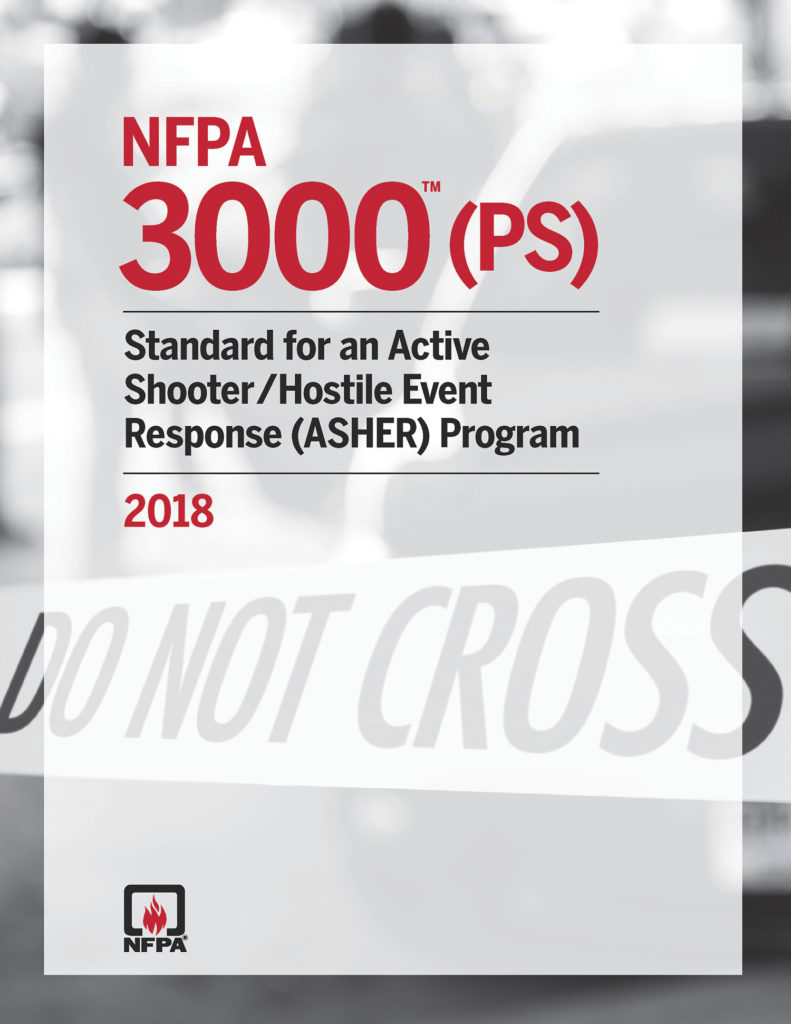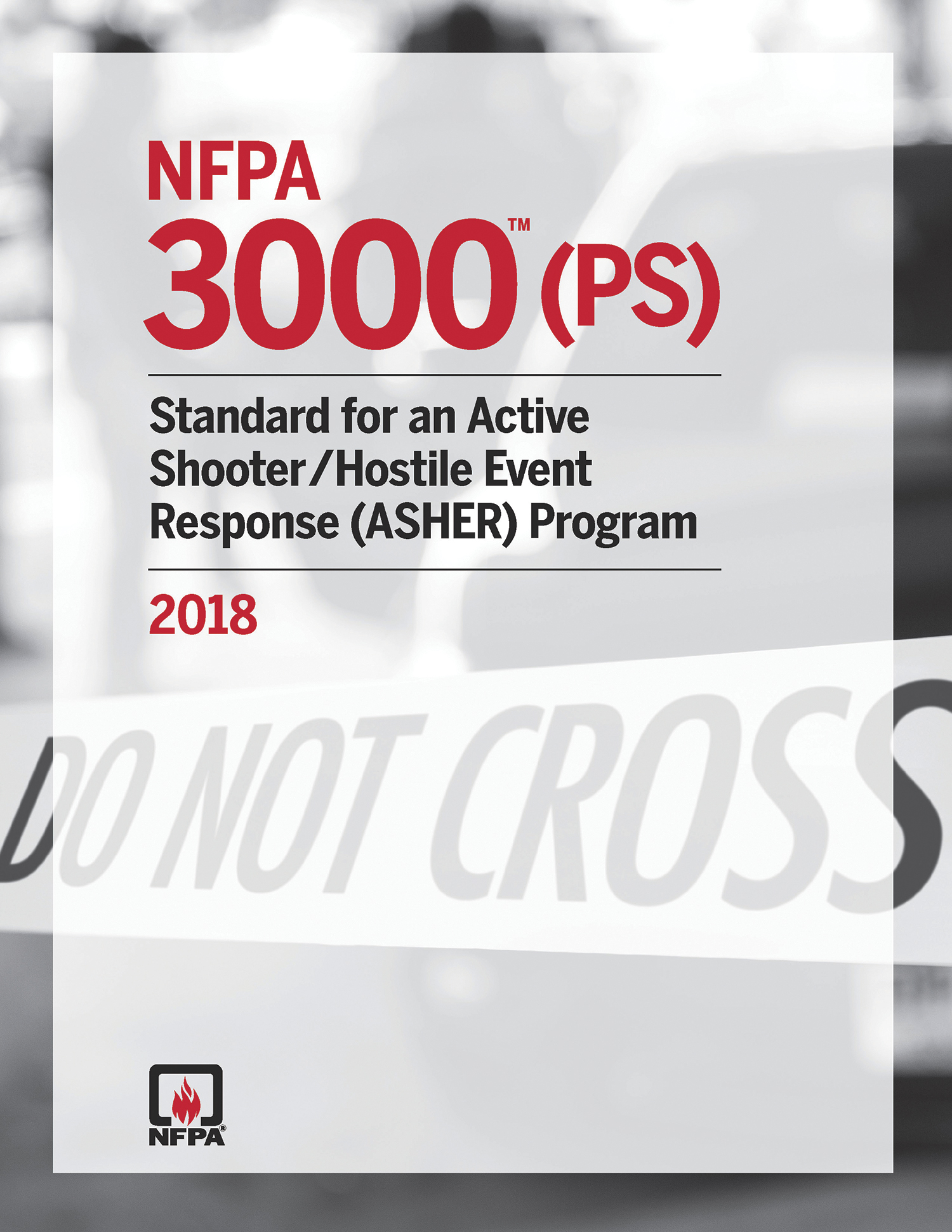If portions of this post look familiar to you, it’s because I added more about the development of the standard to an earlier post and this will be published in the August 2018 issue of Door Security + Safety
 The National Fire Protection Association (NFPA) has released a new standard – NFPA 3000TM (PS), Standard for an Active Shooter/Hostile Event Response (ASHER) Program. Development of the standard began after the mass shooting at the Pulse Nightclub in Orlando, Florida, which occurred in June of 2016. Chief Otto Drozd of Orange County Fire in Florida requested that NFPA develop a standard to guide authorities in creating a response plan for active shooter/hostile events. Planning began late in 2016 and the completed standard was released less than a year and a half later.
The National Fire Protection Association (NFPA) has released a new standard – NFPA 3000TM (PS), Standard for an Active Shooter/Hostile Event Response (ASHER) Program. Development of the standard began after the mass shooting at the Pulse Nightclub in Orlando, Florida, which occurred in June of 2016. Chief Otto Drozd of Orange County Fire in Florida requested that NFPA develop a standard to guide authorities in creating a response plan for active shooter/hostile events. Planning began late in 2016 and the completed standard was released less than a year and a half later.
While development of most codes and standards often seems to move slowly – with a cycle of 3 years or more, NFPA 3000 was created as a provisional standard. Provisional standards address an emergency situation or other special circumstance, and are developed using an expedited process. NFPA 3000 is only the second standard to be issued by NFPA as a provisional standard since the organization was founded in 1896. The first provisional standard, NFPA 56, was created in response to a power plant explosion in 2010, where 6 people were killed and close to 50 injured.
Because of the increase in hostile events in the United States, NFPA’s Standards Council unanimously approved the new standards project, and development of NFPA 3000 was fast-tracked. NFPA solicited comments from the public as well as applications for Technical Committee members at the beginning of 2017; within three months, more than 130 comments and 85 applications were received. The NFPA Technical Committee on Cross Functional Emergency Preparedness and Response was established in April 2017, consisting of representatives from the Department of Homeland Security, Department of Justice, the Federal Bureau of Investigation, national police, fire, and EMS organizations, personnel from hospitals and universities, and others. Many of the 50 committee members had direct experience with recent mass shootings.
The committee first met on June 14, 2017, with NFPA President Jim Pauley speaking to the group about the many active shooter incidents in recent years – citing events in London, Paris, San Bernardino, Boston, Sandy Hook, Fort Hood, Virginia Tech, and Charleston. “These tragedies highlight a need for first responders, emergency personnel, facility managers, hospital officials, and community members to have information when terror attacks occur,” he said. On the day of the meeting, active shootings occurred in Virginia and San Francisco. All of these events indicated a need for an effective, coordinated response plan that involves the fire service, law enforcement, emergency medical responders, and other public safety agencies.
Committee members met again in September 2017 to continue working on the draft of NFPA 3000. Reviewing various active shooter/hostile events at a high level assisted in determining what was needed to help communities prepare for, respond to, and recover from these events. Task groups were formed within the committee to develop the standard’s twenty chapters which address different components of incident preparedness, response, and recovery using common language to allow emergency responders to communicate clearly. After months of hard work, NFPA 3000 was released on May 1, 2018.
Impact on Physical Security
According to the NFPA 3000 Fact Sheet:
The purpose of NFPA 3000 (PS) is to identify the minimum program elements needed to organize, manage, and sustain an active shooter and/or hostile event response program and to reduce or eliminate the risks, effect, and impact on an organization or community affected by these events. The document addresses the following areas and others:
- Planning – assessing risks, developing community-wide programs
- Responding – establishing competencies, communicating to all stakeholders
- Recovering – planning recovery efforts, taking into account healthcare and mental health issues
Given that NFPA 3000 is a standard for preparation and response to an active shooting, how does that affect the door and hardware industry? Chapter 9 – Facility Preparedness, addresses requirements for facilities that may be at risk of an ASHER incident. In addition to staff procedures, notification of building occupants, periodic drills, and adequate supplies for first-aid response, the chapter covers emergency action plans for evacuation, relocation, and secure-in-place procedures.
There are several key points in this chapter that relate to physical security and lockdown:
- Emergency action plans must include the location and identification of lockable spaces as well as the exit doors leading to the exterior. Doors in the means of egress must meet all of the requirements of NFPA 101 – The Life Safety Code.
- Plans must include procedures to lock designated doors from within the spaces, and must meet the requirements of NFPA 101 with regard to locking/unlocking and unlatching. This includes the ability to unlatch the door from the egress side with one releasing operation, and without a key, tool, special knowledge, or effort. The releasing mechanism for unlocking and unlatching the door must be located between 34 inches and 48 inches above the finished floor.
- Where required by NFPA 101 (classrooms, for example), doors must be lockable from the inside without opening the door, and unlockable from the outside with the necessary key or other credential.
These requirements help to ensure that the secured doors provide for unimpeded egress, allow authorized access, and do not create barriers for people with disabilities. All of these considerations are critical when evaluating security devices and methods for schools as well as other facilities. For the standard, helpful tools, online training, and relevant content, visit nfpa.org/3000news.
You need to login or register to bookmark/favorite this content.







Unfortunately, many schools are already violating NFPA-101 with barricade devices, so this one won’t make much of a difference. Maybe it will help with the ones that are on the fence.
Julia, I agree that some school districts have “jumped the process” and have installed securing devices but we now have a document that ALL jurisdictions can look at for ONE answer on the type of device that can be used. We NEVER had that in the past as everyone wanted to interpret what The Life Safety Code stated (in my opinion)very plainly. Its also a document that will bring all departments (Police, Fire, EMS, School districts and hopefully the Door Hardware Industry together. One of the things that it does bring out is what to do AFTER the event. I have heard a number of presenters at conferences explain what happened after the event was quite overwhelming to all involved in managing the aftermath where things happened that nobody even thought of let alone handle. The document is out there …now lets see who has the insight to correctly implement it!!!